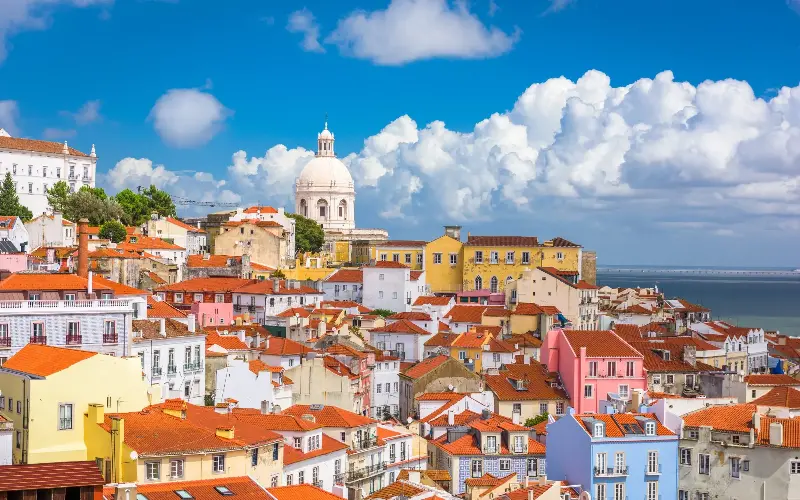
Lisbon is having a moment. It is the place on everyone’s lips and its breezy sea views, glossy-tiled façades and red roofs feature on many Instagram feeds. The food surprises, with a depth far beyond the famous pastéis de nata (custard tarts) that are so known and loved. There is history; from the 12th-century Moorish castle that dominates the skyline to the magnificent 16th-century Manueline monastery of Jerónimos, and the bombastic 18th-century heart of Lisbon, built after so much of the city was destroyed in the 1755 earthquake.
There is authentic, genuine and welcoming hospitality; and a wave of new and affordable hotels along cobbled streets and flanking bougainvillea-clad squares. Lisbon, unlike so much of the world, has not gone global: it remains resolutely Portuguese, looking out to sea, with its back to the rest of Europe and its identity intact. Here’s how to spend 48 hours in this exciting city.
For more Lisbon inspiration, see our guides to the city’s best hotels, restaurants, bars, shopping and attractions.
In this guide:
- What’s new in Lisbon this season
- How to spend your weekend
- When should I visit Lisbon?
- Where to stay in Lisbon?
What’s new in Lisbon this summer
See: The Armando Martins Museum of Contemporary Art
The Armando Martins Museum of Contemporary Art (MACAM) recently opened in the former Condes da Ribeira Grande Palace. Its wonderful private collection offers a journey through Portuguese art from the late 19th century to the present day. There’s a hotel on site for those who can’t tear themselves away, along with a restaurant, plus a bar housed in a former chapel.
Eat: Cervejaria Liberdade
This classic restaurant on the main thoroughfare of Avenida Liberdade has reopened after a complete refresh by Galician design company Martinez Otero, with clay tiles by Maora Ceramic and tableware by Portugal’s renowned Vista Alegre. As part of the Tivoli Avenida Liberdade Lisboa hotel, you can expect classic trolley service: steak tartare and crêpes suzette are prepared before you, which feature on the menu alongside the freshest of John Dory fish fillets with cockle rice.
Stay: The Verse
This centrally located house has been turned into 15 stylish apartments by renowned interior designer Joana Astolfi and are perfect to use as a base for exploring Lisbon. The Verse’s cocktail bar, on the ground floor, makes an ideal meeting point and offers a chance to sample Portuguese gins and local wines.
How to spend your weekend
Day one: morning
Begin with a food-focused walking tour which puts the city into context as you go. Highly recommended are Culinary Backstreets, who will take you into an authentic, hidden Lisbon in which generations of families have been salting cod or preparing chicken piri-piri over charcoal pits.
Lisbon’s domed 19th-century market hall, the Mercado de Ribeira, was converted in 2014 into the Time Out Market, a buzzy food hall, which remains a huge draw. Some of Lisbon’s best culinary experiences can be found here, from outlets of Michelin-starred chefs such as Henrique Sa Pessoa to exquisite melt-in-the mouth hams and unctuous Serra da Estrela cheese at Manteigaria Silva, a Lisbon institution. Or, lunch on sushi with a twist at Confraria.
Afternoon
The district of Bélem lies along the Tagus River and contains some of the capital’s most interesting historical monuments, such as the Bélem Tower and the 16th-century Mosteiro dos Jeronimos – to get here, take tram 15 or 127 from Praça do Comércio.
This extraordinarily ornate Manueline monastery was built from the taxes imposed on spices that flowed into the country, and contains the tomb of the great navigator Vasco de Gama, who led Portugal’s Golden Age of Discovery, as well as that of writer Luis de Camões who chronicled them.
A few steps from here will bring you to the Café Pastéis de Bélem, named after the custard tarts (also known as pastéis de nata), which originated here in 1837 via a secret recipe from the monastery. They are still served today, warm from the oven and dusted with cinnamon.
Late
Once you have explored the heritage in Bélem, take a walk through the lush Tropical Botanical Garden, created in 1906, which stays open until 8pm in summer, 7pm in autumn and 6pm or 5pm as winter progresses. There are more than 600 species of exotic plants and trees, mainly from former Portuguese colonies, along with ducks and peacocks, a herbarium and a large lake.
Having worked up an appetite, you can neatly tie together the importance of spices in Portuguese history and their use in the contemporary kitchen. Book a table at one-Michelin-starred restaurant Feitoria, which sits on the edge of the river at Bélem, and prepare to have your senses dazzled with dishes by talented chef Andrea Cruz.
Day two: morning
Begin by climbing up the winding medieval streets of Lisbon’s most ancient neighbourhood, Alfama, twisting up to the city’s Moorish pinnacle, Castelo São Jorge. The dusk-orange walls of the ancient castle date back to the ninth century and dominate the city, being visible from almost every street. From here, all of Lisbon is spread out beneath you.
Head to the Gulbenkian Museum, named after one of the 20th century’s great philanthropists, Armenian Calouste Gulbenkian, who left much of his art and historic artefacts to his favoured city, Lisbon. Look out for priceless Hellenic vases, ancient Chinese porcelain and paintings by Rembrandt, Monet and Van Dyck.
Lunch at JNcQUOI, on Lisbon’s main boulevard. It’s perfect for people watching while enjoying the lobster hot dog.
Afternoon
Head out to Sintra and explore this extraordinary aristocratic hill town to the west of the city, a Neverland of fairytale palaces, manicured floral gardens and wild woodlands. Don’t miss the gardens and palace of Monserrate. The train to Sintra departs from Rossio station every 20 minutes and takes about 40 minutes.
On the way back, stop at the busy seaside town of Cascais and indulge in an ice-cream at Santini, an institution in Portugal which has been going strong for 60 years. Walk it off by taking the Atlantic promenade to Estoril, where old palaces from times past stud the waterfront between tall palm trees.
Late
Mini Bar, back in central Lisbon, is one of chef José Avillez’s many restaurants. It’s a gastro-barset within Bairro Avillez and perfect for those who enjoy culinary wizardry. The El Bulli olive is not what it seems; the ceviche of Algarve prawns comes served on a wedge of lime, and the golden egg is made from hummus. The informal atmosphere, affordable prices and friendly staff create a really fun evening out, plus on Fridays and Saturdays there’s a live DJ.
When should I visit Lisbon?
Lisbon is a year-round destination; rarely too hot or cold. Peak season in Lisbon is May and June and again in September and October. Winter is mild, normally in the teens, but mostly with blue skies. Rain tends to be in December and January.
The first buds of spring usually appear around late February (May sees the purple jacaranda trees dominating the boulevards) while the last puffs of the Sahara-warmed winds keep the mercury high well into November.
August is when the locals escape for the breeze of the Algarve and the tourists come en masse for Lisbon’s guaranteed blue skies. But summer visitors could make the most of the lovely beaches within a 25-minute radius of Lisbon. If not, make sure your hotel has a pool.
Where to stay in Lisbon
Luxury living
Four Seasons Hotel Ritz’s prime location near the main Avenida de Liberdade means easy access around the capital and to art museums such as the Gulbenkian nearby. Décor is grand – think chandeliers and huge flower displays on gilded furniture. Outside a sleek new pool awaits.
Read our full review here.
Boutique bolthole
Pink-walled Palácio Príncipe Real sits in Lisbon’s leafiest district. Its 25 rooms overlook the red-roofed capital or the Palacio’s lush gardens (think jacaranda and palm trees, vibrant bougainvillaea and wisteria climbing up its wrought iron staircase) which are inset with a sleek swimming pool.
Double rooms from €495 (£422), year-round.
Read our full review here.
Budget beauty
Hotel Lisboa Plaza, is perfectly located just off Lisbon’s main avenue, Avenida Liberdade, tucked away down a quiet side street. Part of the charming Heritage Hotels group, this property, like its other four, is all about preserving the history and heritage of Lisbon. Filled with fascinating memorabilia from its 1950s heyday, this is a warm and welcoming hotel, suitable for families and pet owners too.
Read our full review here.
Essential information: what to know before you go
- British Embassy: 00 351 21 392 4000; Rua de São Bernardo 33. Open Mon-Fri, 9am-1pm and 2.30pm-5.30pm
- Emergency services: Dial 112
- Lisbon Tourist Office: 00 351 21 031 2819; visitlisboa.com, Praça do Comércio
The basics
- Currency: Euro
- Telephone code: Dial 00 351 for Portugal, then 21 for Lisbon, when telephoning from the UK
- Time difference: None
- Flight time: London to Lisbon is just over two hours
Local laws and etiquette
- If driving, the law requires you to have a fluorescent bib in the car. It’s to be put on should you break down on a busy road and need to be visible to other motorists.
About our expert
Mary has lived in southern Portugal for over 20 years. When she’s in Lisbon, you can find her chatting with the chef at the latest culinary hotspot, checking out a new rooftop bar or sampling the newest hotel on the block.
